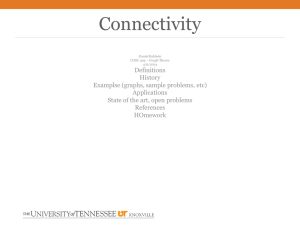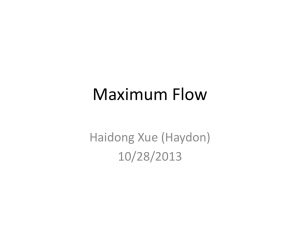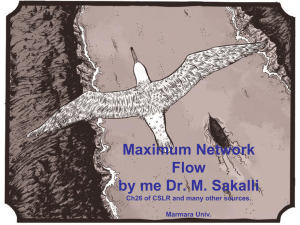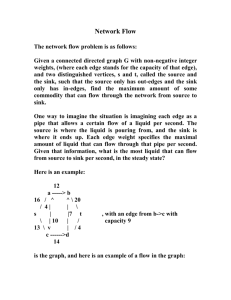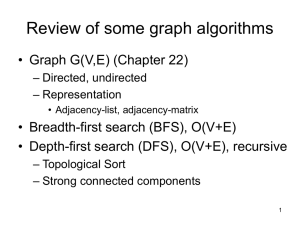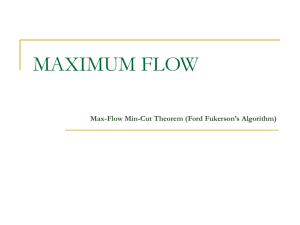docx
advertisement
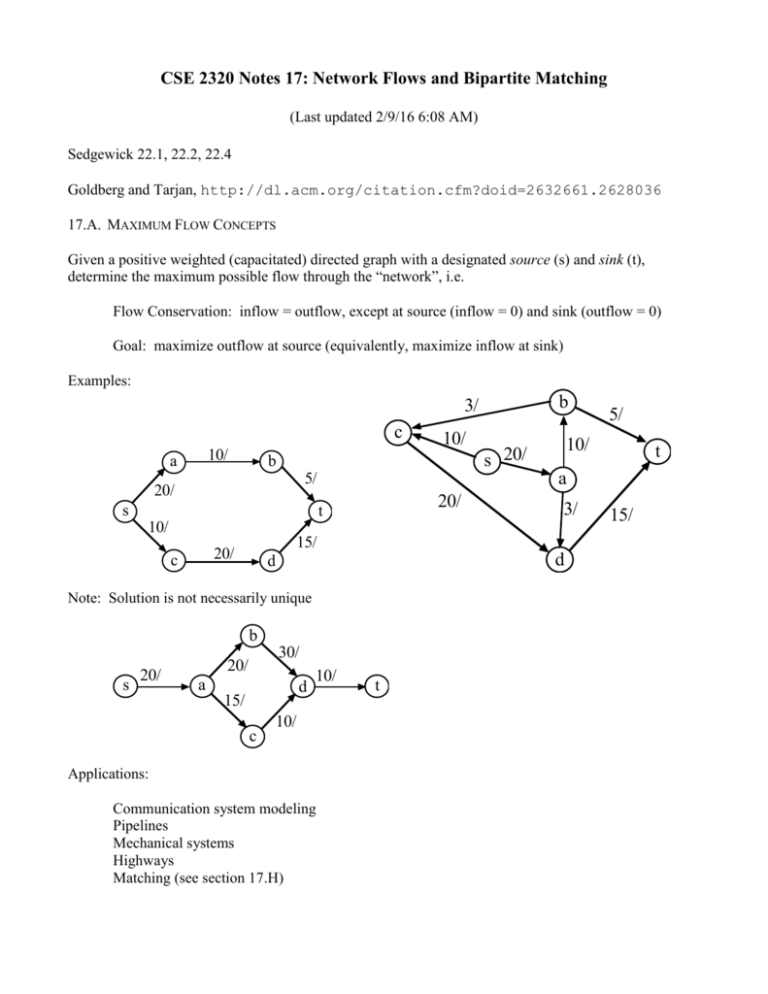
CSE 2320 Notes 17: Network Flows and Bipartite Matching
(Last updated 2/9/16 6:08 AM)
Sedgewick 22.1, 22.2, 22.4
Goldberg and Tarjan, http://dl.acm.org/citation.cfm?doid=2632661.2628036
17.A. MAXIMUM FLOW CONCEPTS
Given a positive weighted (capacitated) directed graph with a designated source (s) and sink (t),
determine the maximum possible flow through the “network”, i.e.
Flow Conservation: inflow = outflow, except at source (inflow = 0) and sink (outflow = 0)
Goal: maximize outflow at source (equivalently, maximize inflow at sink)
Examples:
b
3/
c
10/
a
10/
b
s
10/
s 20/
20/
t
3/
10/
15/
20/
c
d
d
Note: Solution is not necessarily unique
b
s
20/
30/
20/
a
d
15/
c
10/
10/
Applications:
Communication system modeling
Pipelines
Mechanical systems
Highways
Matching (see section 17.H)
t
a
5/
20/
5/
t
15/
2
Observations:
A solution can be found that does not have flow on both edges (x, y) and (y, x).
(Observation does not say that the smaller capacity edge should be removed.)
b
200/150
s
225/225
a
100/50
100/75
225/225
a
50/25
b
100/25
100/75
d
500/225
t
500/225
t
200/100
c
200/150
s
125/125
125/125
50/0
d
200/100
c
Solution is not optimal if an “augmenting path” (A.P.) from the source to sink can be found.
Example:
A.P. s, b, d, t / 2 units
3/
3/
2/
1/
c
2/
d
2/
3/
t
a
b
4/
3/
s
s
s
a
A.P. s, a, c, t / 2 units
3/2
2/2
1/
4/
3/
2/2
c
d
2/
3/2
t
a
b
2/2
1/
b
4/
3/2
c
2/2
d
2/2
3/2
t
3
A.P. s, a, d, t / 1 unit
Suppose that first A.P. was s, a, d, t / 3 units
s
s
3/3
a
3/3
2/2
1/
4/1
3/2
c
a
b
2/2
d
2/2
3/3
t
2/
1/
b
4/3
3/
2/
c
d
2/
3/3
t
To fix this problem, an A.P. may “reverse” and “redirect” a flow:
A.P. s, b, d, a, c, t / 2 units
Remaining Question: If there are no A.P.s (as generalized for previous example), is the flow
maximized?
YES Leads to Ford-Fulkerson Method and Max-flow, Min-cut Theorem.
17.B. FORD-FULKERSON METHOD
Search for A.P.s is facilitated by maintaining a residual network:
1. Initially has the same edges/capacities as input network.
2. The inverse of every edge is included (often with zero capacity).
3. If the flow from vertex u to vertex v is positive, f(u,v) > 0, then the flow from v to u will be
negative, i.e. f(u,v) = -f(v,u).
4. An A.P. is found in the residual network by finding a path of edges where every edge has
remaining capacity (“unsaturated”), f(u,v) < c(u,v). The incremental flow is the minimum
difference, c(u,v) – f(u,v), along the path.
5. An A.P. is recorded twice in the residual network by:
a. Adding the incremental flow to f(u,v) for every edge in the A.P.
b. Subtracting the incremental flow from f(v,u) for every edge in the reverse path.
4
The initial residual network for
the last example is:
A.P. s, a, d, t / 3 units
s
s
3/
a
0/
4/
3/
b
0/
2/
0/
0/
2/
0/-3 0/
1/
a
b
0/
4/3
0/ 2/
3/ 0/
0/
0/-3
c
d
c
d
0/
0/
0/ 0/-3
3/
2/
s
3/3
2/
0/
1/
A.P. s, b, d, a, c, t / 2 units
3/3
2/
t
3/3
2/2
0/-3
0/-2
1/
a
b
0/
4/1
0/-2 2/2
3/2 0/-2
0/-1
c
d
0/-3
0/-2
3/3
2/2
t
t
17.C. MAX-FLOW MIN-CUT THEOREM
Cut: A partition of V into two sets S (“source side”) and T (“sink side”) such that
1. S T =
2. S T = V
3. s S
S
T
4. t T
Capacity of a cut:
å å capacity(x, y)
xÎS yÎT
Lemma: The capacity of any cut is an upper bound on the maximum flow. (will prove later)
5
Example:
a
10/
Consider the cut:
b
5/
20/
s
t
T = {t, a, d}
15/
20/
sa
bt
cd
S = {s, b, c}
10/
c
So the capacity is:
d
20
5
20
---45
Potentially, the flow could be as large as the cut-capacity (i.e. the flow “across” the cut).
Now consider the cut:
sc
bt
S = {s, a, b}
T = {t, c, d}
10
5
---15
The definition of cut does not attempt to avoid counter-intuitive cuts:
s
1/
1/
a
b
1/
1/
c
d
1/
= S vertex
t
= T vertex
Now consider some cuts for:
a
15/
s
12/
b
5/
4/
7/
t
10/
3/
c
d
10/
Cut 1:
Cut 2:
Cut 3:
S = {s}
T = {t, a, b, c, d}
S = {s, a, c}
T = {t, b, d}
S = {s, a, b}
T = {t, c, d}
Capacity = 19
Capacity = 22
Capacity = 14
In general, a min-cut is determined from the residual network at termination of the max-flow algorithm:
1. S includes all vertices reachable from the source using unsaturated edges.
2. T is everything else.
Initial residual network:
A.P. s, a, b, t / 7 units
a
15/
0/
0/
s
12/
0/
0/
4/
3/
4/
0/-4
a
0/
d
0/-10
0/-10 12/10
12/7
0/
0/-7
7/7
t
0/-4
10/4
a
15/10
s
3/
c
10/
A.P. s, a, b, c, d, t / 3 units
0/-7
0/-7
0/
t
5/
10/
15/7
4/4
0/-7
0/
c
d
A.P. s, c, d, t / 4 units
b
0/
3/
10/
s
12/7
7/7
0/
10/
0/
0/
c
b
5/
0/
t
7/
0/
0/-7
0/-7
s
b
0/
a
15/7
5/
10/4
b
4/4
0/-4
0/-3
0/
0/-7
7/7
3/3
0/-4
d
c
0/-7
10/7
The following sequence of A.P.s also leads to the same final residual network:
s, a, b, c, d, t / 3 units
s, c, d, a, b, t / 4 units
s, a, d, c, b, t / 3 units
s, a, b, c, d, t / 3 units
s, a, d, t / 1 unit
t
5/
10/7
0/-7
d
7
Searching the unsaturated edges of the residual network yields the cut S = {s, a, b} T= {t, c, d} with
capacity 14.
a
15/10
0/-10
0/-10
s
b
4/4
0/-4
0/-3
12/10
5/
0/-7
7/7
3/3
c
= S vertex
0/
0/-7
t
= T vertex
10/7
0/-7
d
10/7
17.D. IMPLEMENTING FORD-FULKERSON
Sedgewick gives an implementation of the Maximum Capacity Path method for finding augmenting
paths (program 22.3), included in the source file NetworkMaxFlow.java. This file also includes the
simpler Breadth-First Search of the residual network, commonly known as the Edmonds-Karp method.
1 10/0
1
3
10
1
2
4 3/1
2
1
3
7
0
¥ /1
2
7/0
2
5 2/4
4
4
6 4/2
5
3
2
2
3
3/2
7
4/6
Since both methods require recording each augmenting path in both directions, an input directed edge
(with positive capacity) and its inverse (with zero capacity) are stored together (program 22.2). Each
Edge instance is referenced in two adjacency lists (program 20.4).
No attempt is made to coalesce parallel edges, so in spite of the earlier observation regarding flow on an
edge and its inverse, the provided code can have flow from x to y and from y to x.
Using Edmonds-Karp BFS
4: 5<-4<-3<-0
7: 5<-2<-1<-0
3: 5<-4<-3<-2<-1<-0
Edge capacities/flows
0->3 4/4
0->1 15/10
1->2 12/10
2->5 7/7
2->3 3/3
3->4 10/7
4->5 10/7
4->1 5/0
Max flow is: 14
S side: 0 1 2
T side: 3 4 5
Using maximum capacity paths
7: 5<-2<-1<-0
4: 5<-4<-3<-0
3: 5<-4<-3<-2<-1<-0
Edge capacities/flows
0->3 4/4
0->1 15/10
1->2 12/10
2->5 7/7
2->3 3/3
3->4 10/7
4->5 10/7
4->1 5/0
Max flow is: 14
S side: 0 1 2
T side: 3 4 5
An inefficient implementation ( http://ranger.uta.edu/~weems/NOTES2320/ff.c ) is easily implemented
using adjacency matrices for the residual network, but wastes time scanning over non-existant edges
during breadth-first search.
An efficient implementation ( http://ranger.uta.edu/~weems/NOTES2320/ffLab.c ) involves additional
details for building compressed adjacency lists for the residual network. The following example
illustrates the phases:
1
1/
0
2/
1/
3
1/
2/
1/
2
% a.out
4 6
0 1 1
0 2 2
1 2 1
2 1 1
1 3 2
2 3 1
Input & inverses:
i tail head cap
0
0
1
1
1
1
0
0
2
0
2
2
3
2
0
0
4
1
2
1
5
2
1
0
6
2
1
1
7
1
2
0
8
1
3
2
9
3
1
0
10
2
3
1
11
3
2
0
qsort CPU 0.000027
Sorted edges:
i tail head cap
0
0
1
1
1
0
2
2
2
1
0
0
3
1
2
0
4
1
2
1
5
1
3
2
6
2
0
0
7
2
1
1
8
2
1
0
9
2
3
1
10
3
1
0
11
3
2
0
Coalesced edges:
i tail head cap
0
0
1
1
1
0
2
2
2
1
0
0
3
1
2
1
4
1
3
2
5
2
0
0
6
2
1
1
7
2
3
1
8
3
1
0
9
3
2
0
9
set inverses CPU 0.000035
Initialized residual network:
Vertex firstEdge
0
0
1
2
2
5
3
8
=================
4
10
i tail head cap inv
0
0
1
1
2
1
0
2
2
5
2
1
0
0
0
3
1
2
1
6
4
1
3
2
8
5
2
0
0
1
6
2
1
1
3
7
2
3
1
9
8
3
1
0
4
9
3
2
0
7
3<-1<-0 adds 1 incremental flow
3<-2<-0 adds 1 incremental flow
3<-1<-2<-0 adds 1 incremental flow
3 augmenting paths
S side of min-cut:
0
T side of min-cut:
1
2
3
total flow is 3
Ford-Fulkerson time 0.000293
flows along edges:
0->1 has 1
0->2 has 2
1->3 has 2
2->1 has 1
2->3 has 1
17.E. FORD-FULKERSON CORRECTNESS
Definitions: Given a cut (S, T):
1. Capacity = sum of capacities over the edges going from the S-side to the T-side:
å å capacity(x, y)
xÎS yÎT
2. Given a flow assignment (observes flow conservation) for a network, the net flow across a cut is the
sum:
å å f (x, y) - å å f (x, y)
xÎS yÎT
xÎT yÎS
(Consider only the positive flow values, not the negative flow values.)
10
a
15/10
s
12/10
b
5/
4/4
t
7/7
10/7
3/3
c
d
10/7
Cut 1:
Cut 2:
Cut 3:
S = {s}
T = {t, a, b, c, d}
S = {s, a, c}
T = {t, b, d}
S = {s, a, b}
T = {t, c, d}
Capacity = 19
Capacity = 22
Capacity = 14
Flow Across Cut =
Flow Across Cut =
Flow Across Cut =
Claim 1: Net flow across any cut = Amount of flow (from source to sink)
b
d
s
a
e
f
S’
T’
i
t
g
h
c
Amount of flow = f(a) + f(b) + f(c) = f(h) + f(i) + f(c)
Observe S’: f(a) + f(g) = f(f) + f(h), so f(a) = f(h) + f(f) – f(g)
Net flow across cut = f(b) + f(c) + f(h) + f(f) – f(g), but previous step allows substitution of f(a)
= f(b) + f(c) + f(a) = Amount of flow
11
Claim 2: Flow from s to t is bounded by any cut’s capacity
Capacity of cut f(b) + f(c) + f(f) + f(h) and f(f) + f(h) f(a) (since f(f) + f(h) = f(a) + f(g))
Thus, capacity of cut f(a) + f(b) + f(c) = Amount of flow
(Note: In a min-cut f(g) = 0.)
Max-flow Min-cut Theorem: If f is a flow assignment, then the following are equivalent:
1. f is a max-flow.
2. No A.P.s in residual network.
3. The amount of flow for f is the same as the capacity of some cut
Proof: 1 2 3 1
1 2: By contradiction. If there is an A.P., then the flow may be increased.
2 3: If there are no A.P.s, then search on unsaturated edges of residual network gives a min-cut.
3 1: By contradiction. If f is not a max-flow, then f cannot be as large as the capacity of any cut.
17.F. FORD-FULKERSON COMPLEXITY ISSUES
Will assume that capacities are integers. Otherwise, termination (due to arithmetic accuracy or irrational
numbers) becomes an issue.
The original Ford-Fulkerson technique makes no assumption about choosing an A.P.
Classic bad case (unlikely in practice).
a
M
M
s
1
M
t
M
b
Can lead to 2M A.P.s that each contribute one unit of flow.
12
Since the number of bits (in the input file) to represent a number of magnitude M is (log M), FordFulkerson has the theoretical potential to take exponential time.
17.G. EDMONDS-KARP VARIANT OF FORD-FULKERSON
Concept: Choose A.P. using BFS on residual network to obtain a path with smallest number of edges.
Guarantees O(VE) A.P.s and O(VE2) time.
Critical edge on an A.P.
Based on min { capacity – flow } for all edges in an A.P.
No capacity will remain on edge after A.P. is recorded (saturated).
13
Observations
Edge may be the critical edge for several A.P.s.
A vertex cannot get closer to source in later rounds of BFS. (See appendix)
Flow must be sent in opposite direction by another A.P. before an edge can become critical
again.
First time critical
s
a
Dist = i
b
Dist = i+1
t
s
a
Dist ≥ i+2
b
Dist ≥ i+1
t
a
Dist ≥ i+2
b
Dist ≥ i+3
t
Later
Second time critical
s
The number of distinct distances available for the tail of a repeated critical edge is bounded above by
(V-2)/2. The number of edges that become critical is bounded above by E. Thus, O(VE) A.P.s overall.
17.H. BIPARTITE MATCHING - Classic application of network flows.
Consider a bipartite graph with two disjoint sets of vertices, U (employees) and V (jobs), along with a
set of edges showing which employees can handle which jobs (no teamwork and no multi-tasking
superstars).
You would like to choose the maximum size subset of edges to match employees to jobs.
Example:
0
A
1
B
2
C
14
The following construction gives a corresponding instance of network flow.
Include source (s) and sink (t).
Direct all edges from U to V.
Include an edge from the source to each U vertex.
Include an edge from each V vertex to the sink.
Set each capacity to one.
For the example:
s
0
A
1
B
2
C
t
Suppose the first two A.P.s are s, 0, A, t and s, 2, C, t. (This may be done during a preprocessing phase
that scans the adjacency list structure for unpaired vertices.)
s
0
A
1
B
2
C
t
But recall that in the residual network there will be a unit of residual capacity on C 2 and A 0, so
the A.P. s, 1, C, 2, A, 0, B, t is available.
s
0
A
1
B
2
C
t
This gives a (perfect) matching of {(0, B), (1, C), (2, A)}. Note that each A.P. causes a net increase of
only one pair.
15
Appendix (aside): Distance from Source to Vertex in Edmonds-Karp Residual Network does not
Decrease (part of proof of property 22.7 in Sedgewick).
i
s
j
v
t
(i-c≤)k
c r’
u
r
p
w
q(≤i-c-r’-1)
Proof is based on claim that distance from s to v decreases when the residual network is updated for an
augmenting path found by BFS (a shortest path from s to t). All path distances shown (except q) are
shortest paths (by counting edges) between a pair of vertices.
Let s u w t be a shortest path from s to t, so k + r + p i + j. Also, i k + c
(for shortest path from s v) and r + p c + j.
After s u w t is chosen as A.P., all edges along the inverse path w u
appear (unsaturated) in the residual network. (The numbers of edges, r’, on the shortest path from w to u
is no larger than r.)
Now, what if the path s w u v brings v closer than the previous distance i
from s, i.e. q + r’ + c i - 1 edges and q i - c - r’ - 1?
Since i k + c, we have i - c k implying q k - r’ - 1 and that the wrong A.P. was chosen (should have
gone from s w t without u w to give no more than k - r’ - 1 + p edges from s
to t). Thus, claiming that the distance from s to v decreases contradicts the fact that the A.P. chosen has
the smallest number of edges.
Corollary: Distance from vertex to sink in Edmonds-Karp residual network does not decrease.
Proof: Similar to preceding proof.
